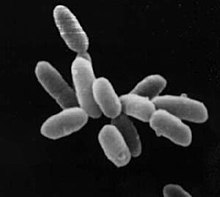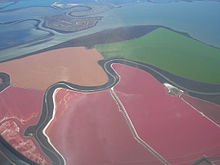Haloarchaea
| Haloarchaea | |
|---|---|

| |
µm in length.
| |
| Scientific classification | |
| Domain: | |
| Kingdom: | |
| Phylum: | |
| Class: | Halobacteria Grant et al. 2002
|
| Order | |
| Synonyms | |
| |
Haloarchaea (halophilic archaea, halophilic archaebacteria, halobacteria)
These
Haloarchaea can grow aerobically or anaerobically. Parts of the membranes of haloarchaea are purplish in color,[5] and large blooms of haloarchaea appear reddish, from the pigment bacteriorhodopsin, related to the retinal pigment rhodopsin, which it uses to transform light energy into chemical energy by a process unrelated to chlorophyll-based photosynthesis.
Haloarchaea have a potential to solubilize phosphorus. Phosphorus-solubilizing halophilic archaea may well play a role in P (phosphorus) nutrition to vegetation growing in hypersaline soils. Haloarchaea may also have applications as inoculants for crops growing in hypersaline regions.[6]
Taxonomy
The extremely halophilic, aerobic members of Archaea are classified within the family Halobacteriaceae, order Halobacteriales in Class III. Halobacteria of the phylum Euryarchaeota (International Committee on Systematics of Prokaryotes, Subcommittee on the taxonomy of Halobacteriaceae). As of May 2016, the family Halobacteriaceae comprises 213 species in 50 genera.
Gupta et al.[7][8] divides the class of Halobacteria in three orders.
- Halobacteriales Grant and Larsen 1989
- Haloarculaceae Gupta et al. 2016, 10 genera
- Halobacteriaceae Gibbons 1974, 24 genera
- Halococcaceae Gupta et al. 2016, 1 genus
- Haloferacales Gupta et al. 2015
- Haloferacaceae Gupta et al. 2015, 10 genera
- Halorubraceae Gupta et al. 2016, 9 genera
- Natrialbales Gupta et al. 2015
- NatrialbaceaeGupta et al. 2015, 18 genera
Phylogeny
The currently accepted taxonomy is based on the List of Prokaryotic names with Standing in Nomenclature (LPSN)[9] and National Center for Biotechnology Information (NCBI).[2]
| 16S rRNA based | 53 marker proteins based GTDB 08-RS214[13][14][15] | ||||||||||||||||||||||||||||||||||||||||||||||||||||||||||||||||||||||||||||||||||||||||||||||||||||||||||||||||||||||||
|---|---|---|---|---|---|---|---|---|---|---|---|---|---|---|---|---|---|---|---|---|---|---|---|---|---|---|---|---|---|---|---|---|---|---|---|---|---|---|---|---|---|---|---|---|---|---|---|---|---|---|---|---|---|---|---|---|---|---|---|---|---|---|---|---|---|---|---|---|---|---|---|---|---|---|---|---|---|---|---|---|---|---|---|---|---|---|---|---|---|---|---|---|---|---|---|---|---|---|---|---|---|---|---|---|---|---|---|---|---|---|---|---|---|---|---|---|---|---|---|---|---|
|
|
Note: * paraphyletic Halobacteriaceae
Molecular signatures
Detailed phylogenetic and comparative analyses of genome sequences from members of the class Haloarchaea has led to division of this class into three orders,
Living environment

Haloarchaea require salt concentrations in excess of 2 mol/L (or about 10%, three times the
Haloarchaea are found mainly in hypersaline lakes and solar salterns. Their high densities in the water often lead to pink or red colourations of the water (the cells possessing high levels of carotenoid pigments, presumably for UV protection).[18] The pigmentation will become enhanced when oxygen levels are low due to an increase in a red pigmented ATP. [16] Some of them live in underground rock salt deposits, including one from middle-late Eocene (38-41 million years ago).[19] Some even older ones from more than 250 million years ago have been reported.[20] Haloarchaea is also used to treat water that is high in salinity. This is due to its ability to withstand high nutrient levels and the heavy metals that may be present. [16]
Adaptations to environment
Haloarchaea can grow at an aw close to 0.75, yet a
Haloarchaea have adapted to use glycerol as a carbon and energy source in catabolic processes, which is often present in high salt environments due to Dunaliella species that produce glycerol in large quantities.[24]
Phototrophy
Cellular shapes
Haloarchaea are often considered pleomorphic, or able to take on a range of shapes—even within a single species. This makes identification by microscopic means difficult, and it is now more common to use gene sequencing techniques for identification instead.
One of the more unusually shaped Haloarchaea is the "
As exophiles
Haloarchaea have been proposed as a kind of life that could
Medical use
Certain types of haloarchaea have been found to produce carotenoids, which normally has to be synthesized using chemicals. With haloarchaea naturally producing it, there is now a natural way to synthesize carotenoids for medical use. [29] Haloarchaea has also been proposed to help meet the high demand of carotenoids by pharmaceutical companies due to how easy it can be grown in a lab.[30] Genes in Haloarchaea can also be manipulated in order to produce various strands of carotenoids, further helping meet pharmaceutical companies needs.[29]
Haloarchaea is also present within the human gut, mostly predominant in the gut of people who live in Korea. Haloarchaea are most abundant in Koreans guts rather than methanogens due to their saltier diets. This also shows that the archaeome in the human gut can vary drastically depending on region and what is eaten.[31]
Climate change
Haloarchaea have been proposed that certain types can be used to make biodegradable plastics, which could help decrease plastic pollution. Haloarchaea are able to produce polyhydroxyalkanote (PHA), polyhydroxybutyrate (PHB) and polyhydroxyvalerate (PHV), when exposed to certain conditions. For large scale production of these bioplastics, haloarchaea is favored due to the low cost, fast growth, and lack of need to sterilize area due to the salty environment they prefer. They are also a cleaner option for bioplastics due to them not needing chemicals for cell lysis and have a higher recyclability of the process. [32]
Certain types of haloarchaea have also been found to poses denitrifying characteristics. If haloarchaea are complete denitrifies, they could aid salt marsh and other salty environments by buffering these areas of nitrate and nitrite. This could help animal diversity and decrease pollution with in these waterways. However, when tested in the lab, haloarchaea have been found to be partial denitrifies. This means that if haloarchaea are used to treat areas that are high in nitrite and nitrate, they could contribute to nitrogen contaminates and cause an increase in ozone depletion, furthering climate change.[33] The only type of haloarchaea that has been found to reduce nitrogen pollution to atmospheric nitrogen has been Haloferax mediterranei. [34] This shows that haloarchaea may be contributing to nitrogen pollution and isn't a suitable solution to reducing nitrate and nitrite within high salinity areas.
See also
- Life on Mars
- Purple Earth hypothesis
- List of Archaea genera
References
- PMID 21984879.
- ^ a b Sayers; et al. "Halobacteria". National Center for Biotechnology Information (NCBI) taxonomy database. Retrieved 2022-06-05.
- PMID 18485204.
- ISBN 9780470015902.
- ^ S2CID 119341330.
- PMID 26216440.
- ^ PMID 25428416.
- S2CID 10437481.
- ^ J.P. Euzéby. "Halobacteria". List of Prokaryotic names with Standing in Nomenclature (LPSN). Retrieved 2021-11-17.
- ^ "The LTP". Retrieved 10 May 2023.
- ^ "LTP_all tree in newick format". Retrieved 10 May 2023.
- ^ "LTP_06_2022 Release Notes" (PDF). Retrieved 10 May 2023.
- ^ "GTDB release 08-RS214". Genome Taxonomy Database. Retrieved 10 May 2023.
- ^ "ar53_r214.sp_label". Genome Taxonomy Database. Retrieved 10 May 2023.
- ^ "Taxon History". Genome Taxonomy Database. Retrieved 10 May 2023.
- ^ S2CID 236158869.
- PMID 26216440.
- ISSN 0003-0996.
- PMID 25338080.
- S2CID 25102006.
- PMID 25500507.
- S2CID 85703396.
- PMID 9670799.
- ^ PMID 27768817.
- S2CID 21222667.
- PMID 16997562.
- ^ DasSarma S (2006). "Extreme halophiles are models for astrobiology" (PDF). Microbe-American Society for Microbiology. 1 (3): 120. Archived from the original (PDF) on 2007-02-02.
- S2CID 19041112.
- ^ PMID 32155882.
- S2CID 232419066.
- PMID 32753050.
- PMID 33803653.
- PMID 29237000.
- S2CID 53292259.
Further reading
Journals
- Soppa J (March 2006). "From genomes to function: haloarchaea as model organisms". Microbiology. 152 (Pt 3): 585–590. PMID 16514139.
- Cavalier-Smith T (January 2002). "The neomuran origin of archaebacteria, the negibacterial root of the universal tree and bacterial megaclassification". International Journal of Systematic and Evolutionary Microbiology. 52 (Pt 1): 7–76. PMID 11837318.
- Woese CR, Kandler O, Wheelis ML (June 1990). "Towards a natural system of organisms: proposal for the domains Archaea, Bacteria, and Eucarya". Proceedings of the National Academy of Sciences of the United States of America. 87 (12): 4576–4579. PMID 2112744.
- Cavalier-Smith T (1986). "The kingdoms of organisms". Nature. 324 (6096): 416–417. S2CID 5242667.
Books
- Grant WD, Kamekura M, McGenity TJ, Ventosa A (2001). "Class III. Halobacteria class. nov.". In DR Boone, RW Castenholz (eds.). Bergey's Manual of Systematic Bacteriology Volume 1: The Archaea and the deeply branching and phototrophic Bacteria (2nd ed.). New York: ISBN 978-0-387-98771-2.
- Garrity GM, Holt JG (2001). "Phylum AII. Euryarchaeota phy. nov.". In DR Boone, RW Castenholz (eds.). Bergey's Manual of Systematic Bacteriology Volume 1: The Archaea and the deeply branching and phototrophic Bacteria (2nd ed.). New York: Springer Verlag. pp. 169. ISBN 978-0-387-98771-2.
